Chinese Journal of Computational Physics ›› 2025, Vol. 42 ›› Issue (2): 127-145.DOI: 10.19596/j.cnki.1001-246x.9020
• Research Rapens • Previous Articles Next Articles
Received:2024-09-12
Online:2025-03-25
Published:2025-04-08
Tailin WU. AI for Accelerating Scientific Simulation, Design, Control, and Discovery[J]. Chinese Journal of Computational Physics, 2025, 42(2): 127-145.
Add to citation manager EndNote|Ris|BibTeX
URL: http://www.cjcp.org.cn/EN/10.19596/j.cnki.1001-246x.9020
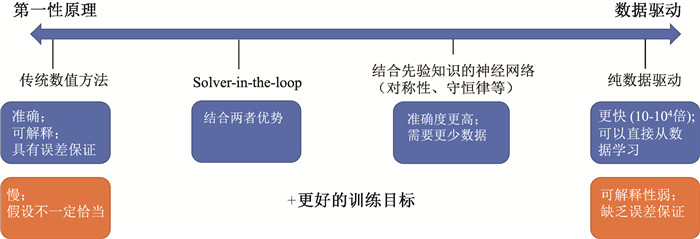
Fig.3 Different simulation methods lying on a spectrum (On the leftmost are classical numerical methods based on first principles. On the rightmost are the pure data-driven methods. Also denoted are the pros and cons for different methods.)
| 优点 | 缺点 | |
| GNN (图神经网络) | 显示地对对象和它们之间关系建模;适用于描述相互作用复杂、非规则网格等;需要较少的样本 | 基础的GNN难以对长程影响建模,需要添加多尺度的边 |
| Transformer (变换器架构) | 比较适合建模长程关系 | 参数量较多,需要较多的训练数据 |
| U-Net (U型神经网络) | 能够建模规则网格中多尺度的动力学 | 只能用于规则网格 |
| Neural operator (神经算子) | 能够实现超分辨率 | 大部分只能适用于规则网格,需要较多训练数据 |
Table 1 Commonly used neural network architecture of AI simulation model and its advantages and disadvantages
| 优点 | 缺点 | |
| GNN (图神经网络) | 显示地对对象和它们之间关系建模;适用于描述相互作用复杂、非规则网格等;需要较少的样本 | 基础的GNN难以对长程影响建模,需要添加多尺度的边 |
| Transformer (变换器架构) | 比较适合建模长程关系 | 参数量较多,需要较多的训练数据 |
| U-Net (U型神经网络) | 能够建模规则网格中多尺度的动力学 | 只能用于规则网格 |
| Neural operator (神经算子) | 能够实现超分辨率 | 大部分只能适用于规则网格,需要较多训练数据 |
| 优点 | 缺点 | |
| 回归 | 最常用场景 | 学习的代理模型对于分布外数据泛化性较差;预测效果不会超出所给目标 |
| 生成模型 | 适用于任何回归用的场景,更适合于高维系统,更适合整体、长程的优化 | 需要一定量的训练数据(但随维度增加,训练数据需要量增加没有回归快) |
| 强化学习 | 预测效果需要超出所给的目标;在整个环境无法求导时仍可以优化 | 样本效率较低,需要与环境的大量交互 |
| 物理信息 | 知道系统的控制方程,可以减少样本的需要量 | 难以泛化到新的边界或者初始条件;系统控制方程不一定准确 |
Table 2 Common learning paradigms of AI simulation models and their advantages and disadvantages
| 优点 | 缺点 | |
| 回归 | 最常用场景 | 学习的代理模型对于分布外数据泛化性较差;预测效果不会超出所给目标 |
| 生成模型 | 适用于任何回归用的场景,更适合于高维系统,更适合整体、长程的优化 | 需要一定量的训练数据(但随维度增加,训练数据需要量增加没有回归快) |
| 强化学习 | 预测效果需要超出所给的目标;在整个环境无法求导时仍可以优化 | 样本效率较低,需要与环境的大量交互 |
| 物理信息 | 知道系统的控制方程,可以减少样本的需要量 | 难以泛化到新的边界或者初始条件;系统控制方程不一定准确 |
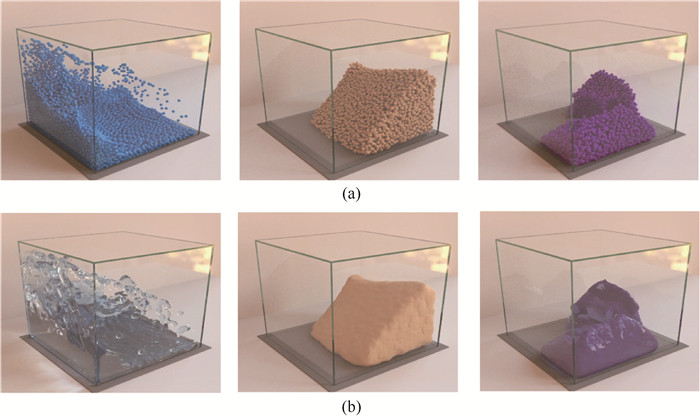
Fig.6 GNS models a physical system as a particle-based system, simulating the temporal dynamics of water (left), sand (middle), and gel (right)[14] (a) prediction results of GNS; (b) after rending
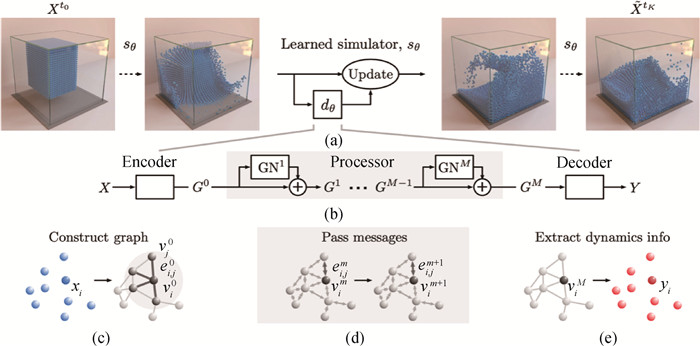
Fig.7 GNS[14] network architecture: The input to the GNS is the state of the system at time t, including every particle's position and velocity. Then through (c) encoder, (d) message passing, and (e) decoder, it predicts the acceleration at time step t+1. Euler's method is used to predict the state at time step t+1.

Fig.8 (a) HGNS architecture[15]; (b) its prediction of water volume (cross-section) vs. ground-truth (We see that its prediction matches well with ground-truth.)
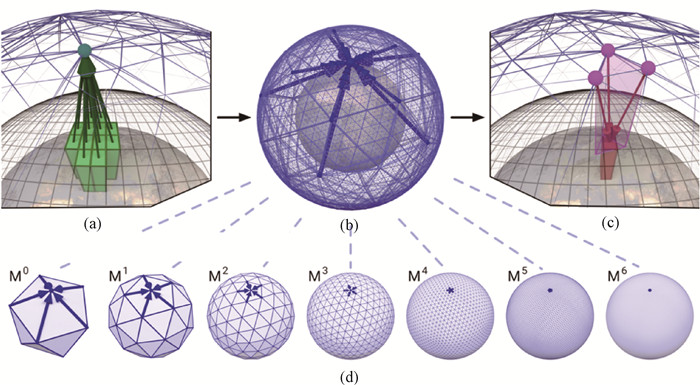
Fig.9 Architecture of GraphCast[16] (Its multiscale graph network can aggregate local and multiscale information.) (a)encoder; (b) processor; (c) decoder; (d) simultaneous multi-mesh message-passing

Fig.12 Task setting for scientific design and control (Based on the objective J, it optimizes the initial condition u0, control sequence m[0, T], parameter a or boundary $\partial \mathbb{X} $.)
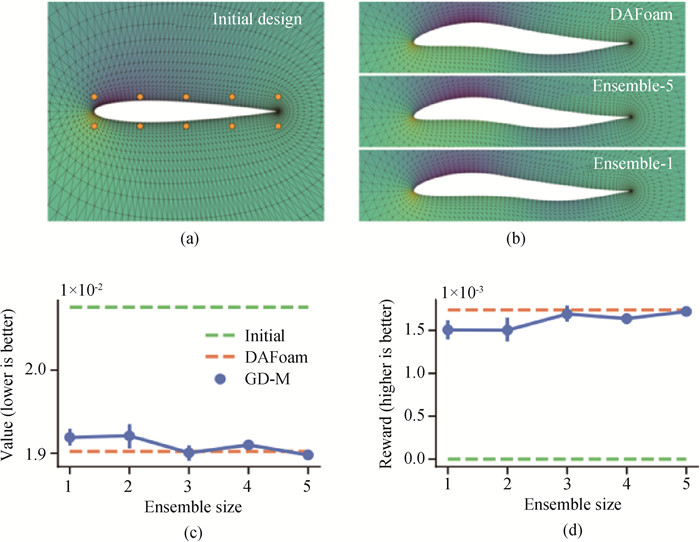
Fig.13 The airfoil design task in Ref.[28], where the design objective is minimizing drag (The surrogate model+backpropagation proposed by the authors attains similar performance as the classical solver (DAFoam), while significantly faster.) (a)initial design; (b) optimized design; (c) drag; (d) reward
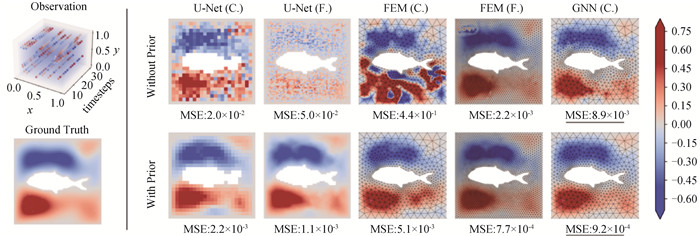
Fig.14 Experimental results Ref.[30] (For the inverse problem, if backpropagation is performed in the original space to optimize the initial conditions of the system (first row, without prior), it will obtain adversarial samples with high-frequency noise. On the other hand, if performing optimization in the latent space as introduced in the paper, due to the prior knowledge, it will attain the initial conditions that match well with the ground-truth.)

Fig.17 Illustration of the interaction between the deep reinforcement learning method[31] and the tokamak device in TCV (a)deployment; (b)TCV; (c)vessel cross section

Fig.19 The system's state trajectory and airfoil shape by simultaneously generated[35] (a) horizontal velocity field; (b) vertical velocity field; (c) pressure field. (It also discovers formation flying, which does not appear in training.)
| 1 |
DOI |
| 2 |
|
| 3 |
DOI |
| 4 |
UM K, BRAND R, HOLL P, THUEREY N. Solver-in-the-Loop: Learning from differentiable physics to interact with iterative pde-solvers[C]. Thirty-fourth Annual Conference on Neural Information Processing Systems(NeurIPS), Vancouver, Canada, 2022.
|
| 5 |
|
| 6 |
DOI |
| 7 |
WANG H, LI J, DWIVEDI A, et al. BENO: Boundary-embedded neural operators for elliptic PDEs[C]. The Twelfth International Conference on Learning Representations(ICLR), Vienna, Austria, 2024.
|
| 8 |
SATORRAS V G, HOOGEBOOM E, WELLING M. E(n) equivariant graph neural networks[C]. The Thirty-eighth International Conference on Machine Learning(ICML), 2021.
|
| 9 |
DOI |
| 10 |
SCHÜTT K T, KINDERMANS P J, SAUCEDA H E, et al. SchNet: A continuous-filter convolutional neural network for modeling quantum interactions[C]. The Thirty-first Annual Conference on Neural Information Processing Systems(NIPS), Long Beach California USA, 2017.
|
| 11 |
WEILER M, FORRÉ P, VERLINDE E, et al. Coordinate independent convolutional networks——isometry and gauge equivariant convolutions on riemannian manifolds[C]. The Twelfth International Conference on Learning Representations(ICLR), Vienna, Austria, 2024.
|
| 12 |
VILLAR S, HOGG D W, STOREY-FISHER K, et al. Scalars are universal: Equivariant machine learning, structured like classical physics[C]. The Thirty-fifth Annual Conference on Neural Information Processing Systems(NeurIPS), 2021.
|
| 13 |
DOI |
| 14 |
SANCHEZ-GONZALEZ A, GODWIN J, PFAFF T, et al. Learning to simulate complex physics with graph networks[C]. The Thirty-seventh International Conference on Machine Learning(ICML), 2020.
|
| 15 |
WU Tailin, WANG Qinchen, ZHANG Yinan, et al. Learning large-scale subsurface simulations with a hybrid graph network simulator[C]//Proceedings of the 28th ACM SIGKDD Conference on Knowledge Discovery and Data Mining. New York: Association for Computing Machinery, 2020: 4184-4194.
|
| 16 |
DOI |
| 17 |
PFAFF T, FORTUNATO M, SANCHEZ-GONZALEZ A, et al. Learning mesh-based simulation with graph networks[C]The Ninth International Conference on Learning Representations(ICLR), 2021.
|
| 18 |
WU T, MARUYAMA T, ZHAO Q, et al. Learning controllable adaptive simulation for multi-resolution physics[C]. The Eleventh International Conference on Learning Representations(ICLR), Kigali, Rwanda, 2023.
|
| 19 |
|
| 20 |
WU Tailin, SUN M, JASON Chou H G, et al. Learning efficient Hybrid particle-continuum Representations of Non-equilibrium N-body systems[EB/OL]. (2023-05-06). https://openreview.net/forum?id=Rd68eTARk4.
|
| 21 |
DOI |
| 22 |
XIE T, FU X, GANEA O E, et al. Crystal diffusion variational autoencoder for periodic material generation[C]. The Tenth International Conference on Learning Representations(ICLR), 2022.
|
| 23 |
LI Z, MEIDANI K, YADAV P, FARIMANI A B. Graph neural networks accelerated molecular dynamics[J]. https://arxiv.org/abs/2112.03383,2022.
|
| 24 |
DOI |
| 25 |
LI Z, KOVACHKI N, AZIZZADENESHELI K, et al. Fourier neural operator for parametric partial differential equations[C]. The Ninth International Conference on Learning Representations(ICLR), 2021.
|
| 26 |
PATHAK J, SUBRAMANIAN S, HARRINGTON P, et al. FourCastNet: A global data-driven high-resolution weather model using adaptive fourier neural operators[C]. The Eleventh International Conference on Learning Representations(ICLR), Kigali, Rwanda, 2023.
|
| 27 |
|
| 28 |
ALLEN K R, LOPEZ-GUEVARA T, STACHENFELD K, et al. Physical design using differentiable learned simulators[C]. The Twelfth International Conference on Learning Representations(ICLR), Vienna, Austria, 2024.
|
| 29 |
WU Tailin, MARUYAMA T, LESKOVEC J. Learning to accelerate partial differential equations via latent global evolution[EB/OL]. Advances in Neural Information Processing Systems, 2022: 10404055(2022-01-01) [2024-07-25]. https://par.nsf.gov/biblio/10404055-learning-accelerate-partial-differential-equations-via-latent-global-evolution.
|
| 30 |
ZHAO Qingqing, LINDELL D, WETZSTEIN G. Learning to solve PDE-constrained inverse problems with graph networks[C]. International Conference on Machine Learning, PMLR, 2022.
|
| 31 |
DOI |
| 32 |
DOI |
| 33 |
YOU J, LIU B, YING R, et al. Graph convolutional policy network for goal-directed molecular graph generation[C]. The Thirty-second Annual Conference on Neural Information Processing Systems(NeurIPS), Montreal, Canada, 2018.
|
| 34 |
OpenAI team. Video generation models as world simulators[EB/OL]. (2024-02-15) [2024-07-25]. https://openai.com/index/video-generation-models-as-world-simulators/.
|
| 35 |
WU T, MARUYAMA T, WEI L, et al. Compositional generative inverse design[C]. The Twelfth International Conference on Learning Representations(ICLR), Vienna, Austria, 2024.
|
| 36 |
DOI |
| 37 |
WEI L, HU P, FENG R, et al. DiffPhyCon: A generative approach to control complex physical systems[C]. The Thirty-eighth Annual Conference on Neural Information Processing Systems(NeurIPS), New Orleans, 2024.
|
| 38 |
DOI |
| 39 |
DOI |
| 40 |
DOI |
| 41 |
YU J, LU Lu, MENG Xuhui, et al. Gradient-enhanced physics-informed neural networks for forward and inverse PDE problems[J]. 2022, 393: 114823.
|
| 42 |
HAO Z, YING C, SU H, et al. Bi-level physics-informed neural networks for PDE constrained optimization using Broyden's hypergradients[C]. The Eleventh International Conference on Learning Representations(ICLR), Kigali, Rwanda, 2023.
|
| 43 |
POKKUNURU A, ROOSHENAS P, STRAUSS T, et al. Improved training of physics-informed neural networks using energy-based priors: A study on electrical impedance tomography[EB/OL]. [2024-07-30]. https://ml4physicalsciences.github.io/2022/files/NeurIPS_ML4PS_2022_92.pdf.
|
| 44 |
DOI |
| 45 |
BARRY-STRAUME J, SARSHAR A, POPOV A A, et al. Physics-informed neural networks for PDE-constrained optimization and control[DB/OL]. arXiv, 2022: 03377(2022-08-18) [2024-07-30]. https://arxiv.org/abs/2205.03377.
|
| 46 |
MOLINARO R, YANG Y, ENGQUIST B, et al. Neural inverse operators for solving PDE inverse problems[C]. The Fortieth International Conference on Machine Learning(ICML), Honolulu, Hawaii, USA, 2023.
|
| 47 |
DOI |
| 48 |
|
| 49 |
|
| 50 |
|
| 51 |
DOI |
| 52 |
UDRESCU S M, TAN A, FENG J, et al. AI Feynman 2.0: Pareto-optimal symbolic regression exploiting graph modularity[C]. Thirty-Fourth Annual Conference on Neural Information Processing Systems(NeurIPS), Vancouver, Canada, 2020.
|
| 53 |
DOI |
| 54 |
LIU Ziming, WANG Yixuan, VAIDYA S, et al. KAN: Kolmogorov-Arnold Networks[DB/OL]. arXiv, 2024: 19756(2024-04-30) [2024-07-30]. https://arxiv.org/abs/2404.19756.
|
| 55 |
LIU Ziming, MA Pingchuan, WANG Yixuan, et al. KAN 2.0: Kolmogorov-arnold networks meet science[DB/OL]. arXiv, 2024: 10205(2024-08-19) [2024-07-30]. https://arxiv.org/html/2408.10205v1.
|
| 56 |
JIANG Z, WANG C, YANG H. Finite expression methods for discovering physical laws from data[C]. The Twelfth International Conference on Learning Representations(ICLR), Vienna, Austria, 2024.
|
| 57 |
DOI |
| 58 |
DOI |
| 59 |
DOI |
| 60 |
|
| 61 |
ALFARANO A, CHARTON F, HAYAT A, et al. Global Lyapunov functions: a long-standing open problem in mathematics, with symbolic transformersp[C]. The Twelfth International Conference on Learning Representations(ICLR), Vienna, Austria, 2024.
|
| 62 |
JANSEN P, CÔTÉ M A, KHOT T, et al. DiscoveryWorld: A virtual environment for developing and evaluating automated scientific discovery agents[C]. The Thirty-eighth Annual Conference on Neural Information Processing Systems(NeurIPS), New Orleans, 2024.
|
| 63 |
MAJUMDER B P, TAFJORD O, CLARK P. ScienceAgentBench: Toward rigorous assessment of language agents for data-driven scientific discovery[C]. The Twelfth International Conference on Learning Representations(ICLR), Vienna, Austria, 2024.
|
| 64 |
|
| [1] | Changheng XU, Hui PAN, Mingtao HE, Changyou ZHAO, Dechang CAI, Huaijin XU. Liquid Heavy Metal Reactor Fuel Rod and Control Rod Design [J]. Chinese Journal of Computational Physics, 2024, 41(5): 582-588. |
| [2] | Ji CHEN, Yi XU, Jinfu LIU, Tao LIU. Dynamics and Implementation of Memristive System Exhibiting Extreme Multistability [J]. Chinese Journal of Computational Physics, 2024, 41(4): 523-534. |
| [3] | Wenmin HAN, Yaodong DAI, Chuqing YAO, Jiaxiang TIAN, Danfeng JIANG, Yifan ZHOU. Application of Genetic Algorithm to Optimal Design of Shielding Materials for Neutron-γ Mixed Radiation Fields [J]. Chinese Journal of Computational Physics, 2024, 41(3): 357-366. |
| [4] | Zhenbo LI, Yezhi TANG. Multivariable Function Projective Synchronization of High Dimensional Chaotic Systems and Its Secure Communication Scheme [J]. Chinese Journal of Computational Physics, 2023, 40(1): 91-105. |
| [5] | Shaoying CHEN, Xueli WANG, Zhimei GAO, Guoyong YUAN. Dynamics of Spiral Waves in Complex Ginzburg-Landau Systems Subjected to Feedback Derived from an Annular Domain [J]. Chinese Journal of Computational Physics, 2022, 39(1): 118-126. |
| [6] | Jing BAI, Zhijing HUANG, Guoning TANG. Terminating Arrhythmia by Using Motion Controller [J]. Chinese Journal of Computational Physics, 2021, 38(3): 352-360. |
| [7] | LIU Yang, DUAN Yang, XU Guoliang, HUANG Xiaoming, CHEN Xintao. An Active Thermal Cloak Suitable for Symmetrical Cross Sections [J]. CHINESE JOURNAL OF COMPUTATIONAL PHYSICS, 2020, 37(6): 718-724. |
| [8] | ZHU Qiaoli, ZHANG Wenhuan. An iDdQ(q-1) Multiple-relaxation-time Lattice Boltzmann Model with External Force [J]. CHINESE JOURNAL OF COMPUTATIONAL PHYSICS, 2020, 37(5): 551-561. |
| [9] | YANG Xiaoyu, WANG Juan, REN Jie, SONG Jianlong, WANG Zongguo, ZENG Zhi, ZHANG Xiaoli, HUANG Sunchao, ZHANG Ping, LIN Haiqing. An Integrated High-throughput Computational Material Platform [J]. CHINESE JOURNAL OF COMPUTATIONAL PHYSICS, 2017, 34(6): 697-704. |
| [10] | WANG Wei, ZENG Yicheng, CHEN Zheng, SUN Ruiting. Coexisting Attractors and Hopf Bifurcation in Floating Memristors Based Chaotic Circuit [J]. CHINESE JOURNAL OF COMPUTATIONAL PHYSICS, 2017, 34(6): 747-756. |
| [11] | CHEN Yongbin, TANG Zhili, SHENG Jianda. Multi-Objective Optimization for Natural Laminar Flow Airfoil in Transonic Flow [J]. CHINESE JOURNAL OF COMPUTATIONAL PHYSICS, 2016, 33(3): 283-296. |
| [12] | ZHOU Yunlong, XU Chao. Hopf Bifurcation in a Fluid-Flow Model of Congestion Control in Wireless Networks with State Feedback Control [J]. CHINESE JOURNAL OF COMPUTATIONAL PHYSICS, 2015, 32(3): 352-360. |
| [13] | SUN Jingjing, HUANG Zhaoqin, YAO Jun, LI Aifen, WANG Daigang. Numerical Simulation of Water Flooding Development in Low Permeability Reservoirs with a Discrete Fracture Model [J]. CHINESE JOURNAL OF COMPUTATIONAL PHYSICS, 2015, 32(2): 177-185. |
| [14] | CHEN Jinfan, LUO Chao, AO Bingyun, PENG Lixia, SHI Jie. Computational and Experimental Study on Mechanical Behavior of V-Ta Alloys [J]. CHINESE JOURNAL OF COMPUTATIONAL PHYSICS, 2014, 31(5): 609-616. |
| [15] | YANG Cuiyun, LIU Haiying, TANG Guoning. Simulation on Control of Spiral Wave by Two-stage Pulse Force [J]. CHINESE JOURNAL OF COMPUTATIONAL PHYSICS, 2014, 31(5): 625-630. |
| Viewed | ||||||
|
Full text |
|
|||||
|
Abstract |
|
|||||
Copyright © Chinese Journal of Computational Physics
E-mail: jswl@iapcm.ac.cn
Supported by Beijing Magtech Co., Ltd.

